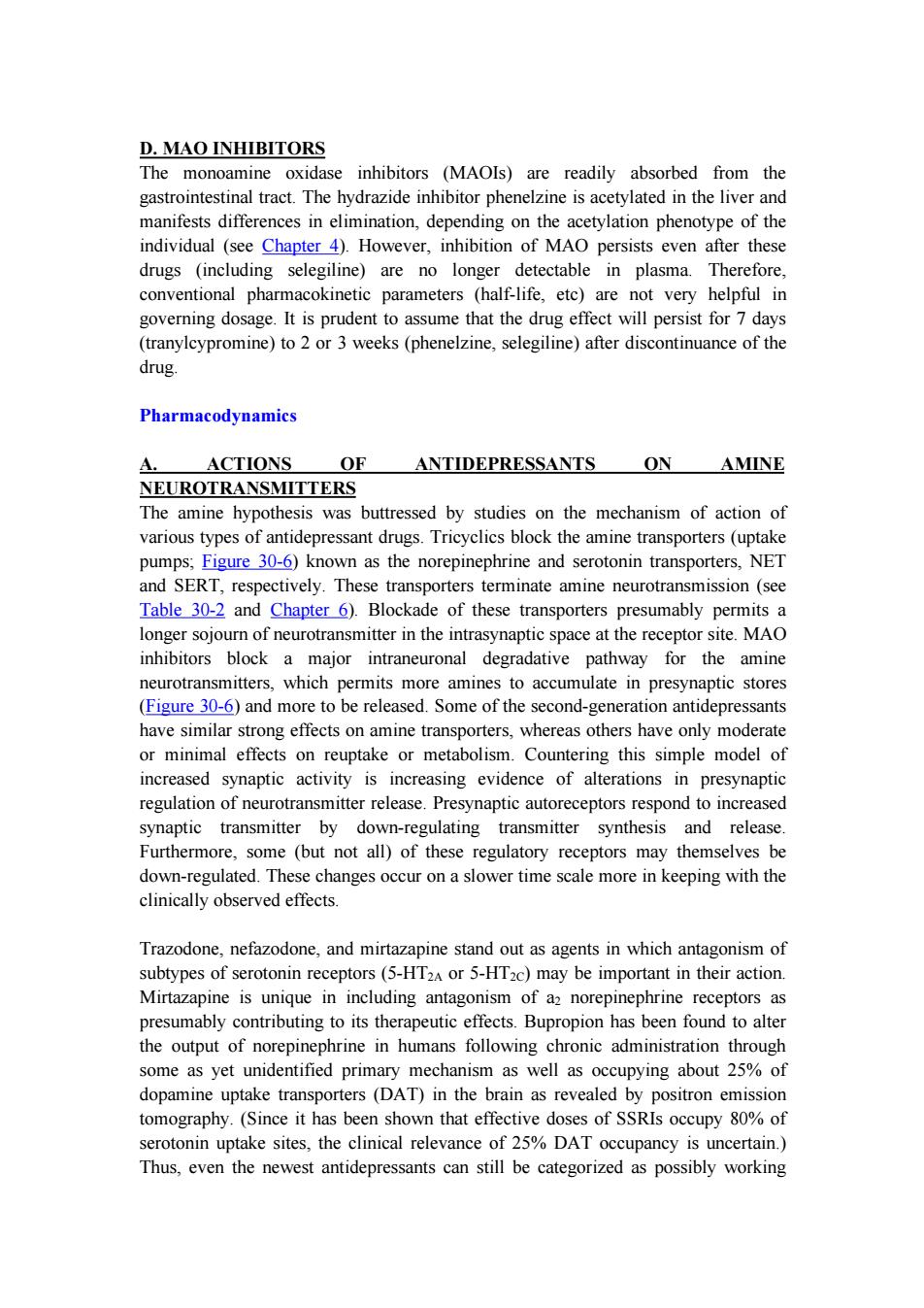正在加载图片...

D.MAO INHIBITORS The monoamine oxidase inhibitors (MAOIs)are readily absorbed from the gastrointestinal tract.The hydrazide inhibitor phenelzine is acetylated in the liver and manifests differences in elimination,depending on the acetylation phenotype of the individual (see Chapter 4).However,inhibition of MAO persists even after these drugs (including selegiline)are no longer detectable in plasma.Therefore, conventional pharmacokinetic parameters (half-life,etc)are not very helpful in governing dosage.It is prudent to assume that the drug effect will persist for 7 days (tranylcypromine)to 2 or 3 weeks(phenelzine,selegiline)after discontinuance of the drug. Pharmacodynamics A ACTIONS OF ANTIDEPRESSANTS ON AMINE NEUROTRANSMITTERS The amine hypothesis was buttressed by studies on the mechanism of action of various types of antidepressant drugs.Tricyclics block the amine transporters(uptake pumps;Figure 30-6)known as the norepinephrine and serotonin transporters,NET and SERT,respectively.These transporters terminate amine neurotransmission (see Table 30-2 and Chapter 6).Blockade of these transporters presumably permits a longer sojourn of neurotransmitter in the intrasynaptic space at the receptor site.MAO inhibitors block a major intraneuronal degradative pathway for the amine neurotransmitters,which permits more amines to accumulate in presynaptic stores (Figure 30-6)and more to be released.Some of the second-generation antidepressants have similar strong effects on amine transporters,whereas others have only moderate or minimal effects on reuptake or metabolism.Countering this simple model of increased synaptic activity is increasing evidence of alterations in presynaptic regulation of neurotransmitter release.Presynaptic autoreceptors respond to increased synaptic transmitter by down-regulating transmitter synthesis and release. Furthermore,some (but not all)of these regulatory receptors may themselves be down-regulated.These changes occur on a slower time scale more in keeping with the clinically observed effects. Trazodone,nefazodone,and mirtazapine stand out as agents in which antagonism of subtypes of serotonin receptors(5-HT2A or 5-HT2c)may be important in their action. Mirtazapine is unique in including antagonism of a2 norepinephrine receptors as presumably contributing to its therapeutic effects.Bupropion has been found to alter the output of norepinephrine in humans following chronic administration through some as yet unidentified primary mechanism as well as occupying about 25%of dopamine uptake transporters(DAT)in the brain as revealed by positron emission tomography.(Since it has been shown that effective doses of SSRIs occupy 80%of serotonin uptake sites,the clinical relevance of 25%DAT occupancy is uncertain.) Thus,even the newest antidepressants can still be categorized as possibly workingD. MAO INHIBITORS The monoamine oxidase inhibitors (MAOIs) are readily absorbed from the gastrointestinal tract. The hydrazide inhibitor phenelzine is acetylated in the liver and manifests differences in elimination, depending on the acetylation phenotype of the individual (see Chapter 4). However, inhibition of MAO persists even after these drugs (including selegiline) are no longer detectable in plasma. Therefore, conventional pharmacokinetic parameters (half-life, etc) are not very helpful in governing dosage. It is prudent to assume that the drug effect will persist for 7 days (tranylcypromine) to 2 or 3 weeks (phenelzine, selegiline) after discontinuance of the drug. Pharmacodynamics A. ACTIONS OF ANTIDEPRESSANTS ON AMINE NEUROTRANSMITTERS The amine hypothesis was buttressed by studies on the mechanism of action of various types of antidepressant drugs. Tricyclics block the amine transporters (uptake pumps; Figure 30-6) known as the norepinephrine and serotonin transporters, NET and SERT, respectively. These transporters terminate amine neurotransmission (see Table 30-2 and Chapter 6). Blockade of these transporters presumably permits a longer sojourn of neurotransmitter in the intrasynaptic space at the receptor site. MAO inhibitors block a major intraneuronal degradative pathway for the amine neurotransmitters, which permits more amines to accumulate in presynaptic stores (Figure 30-6) and more to be released. Some of the second-generation antidepressants have similar strong effects on amine transporters, whereas others have only moderate or minimal effects on reuptake or metabolism. Countering this simple model of increased synaptic activity is increasing evidence of alterations in presynaptic regulation of neurotransmitter release. Presynaptic autoreceptors respond to increased synaptic transmitter by down-regulating transmitter synthesis and release. Furthermore, some (but not all) of these regulatory receptors may themselves be down-regulated. These changes occur on a slower time scale more in keeping with the clinically observed effects. Trazodone, nefazodone, and mirtazapine stand out as agents in which antagonism of subtypes of serotonin receptors (5-HT2A or 5-HT2C) may be important in their action. Mirtazapine is unique in including antagonism of a2 norepinephrine receptors as presumably contributing to its therapeutic effects. Bupropion has been found to alter the output of norepinephrine in humans following chronic administration through some as yet unidentified primary mechanism as well as occupying about 25% of dopamine uptake transporters (DAT) in the brain as revealed by positron emission tomography. (Since it has been shown that effective doses of SSRIs occupy 80% of serotonin uptake sites, the clinical relevance of 25% DAT occupancy is uncertain.) Thus, even the newest antidepressants can still be categorized as possibly working